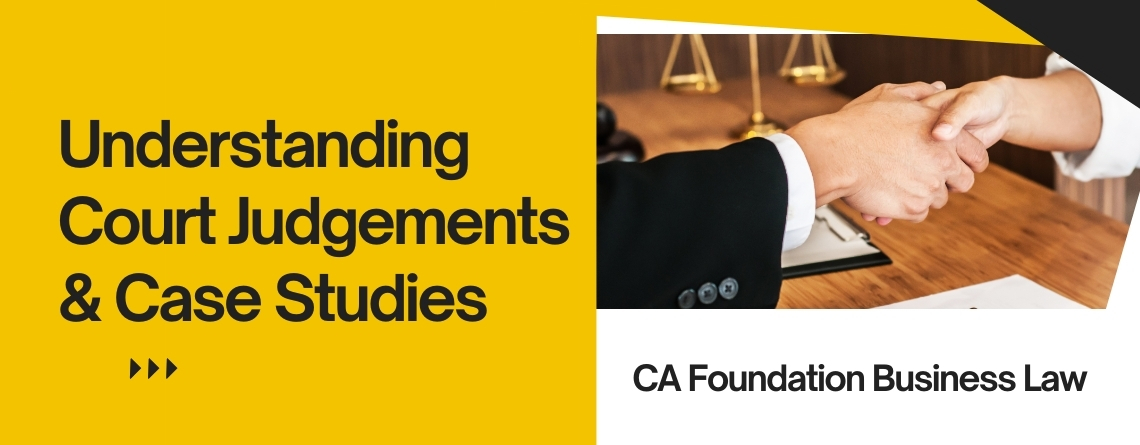Understanding Court Judgements & Case Studies in CA Foundation Business Law
When you’re diving into the world of CA Foundation Business Law, there’s a lot more than just memorizing sections and definitions.
One of the core things every student needs to understand is the difference between “Act” and “Case Study”—something that Rishabh Gaur Sir breaks down brilliantly with real-life examples and clarity that sticks.
Here’s a complete explanation based solely on the conversation provided, keeping the learning crisp, contextual, and easy to recall this concept of CA Foundation class.
What Are You Really Studying? Act vs Case Study
Before we jump into case names like Carlill vs Carbolic Smoke Ball Co. or Boulton vs Jones, let’s first understand what you’re being taught.
- Act: Made by Parliament. This is your Indian Contract Act, with sections, sub-sections, and structured laws.
- Judgement or Case Study: Given by the Courts. These are the real-life applications of the laws—actual cases where judges decided how the law should be used.
So, when your teacher is teaching you Section 2(a), Section 2(b), or Section 2(c) of the Indian Contract Act, and alongside, explaining the Carlill case, they’re combining law with its real-world interpretation. That’s what makes a strong legal foundation.
Why Do We Study Court Judgements?
Imagine you’re a lawyer standing in front of a judge. Your client has a case similar to an old case where the High Court already gave a decision. You’ll refer to that old case and request the judge to give the same decision now. This is called a precedent.
Judges, especially in lower courts like District Court, often follow the decisions made by higher courts like High Courts or Supreme Court—it helps maintain consistency.
So, why study case law?
- It helps lawyers argue better.
- Judges can maintain fairness by following established rulings.
- It clarifies how to apply laws practically.
How Many Case Studies to Remember?
You might be wondering, “Yaar, kitne case studies yaad karun? Har din to naye judgement aate hain!”
That’s the point! Not every case is important, but some become landmark cases—they set a standard, and those are the ones you study in CA Foundation.
Famous ones include:
- Carlill v. Carbolic Smoke Ball Co. (1892)
- Boulton v. Jones
These teach you concepts like:
- General offer vs specific offer
- Acceptance of an offer
- Offer made to the world at large
Watch Full on YouTube:
What is Case Citation?
When you see something written like:
Carlill v. Carbolic Smoke Ball Co. (1892) 2 QB 484
You might ask – What does this mean?
Here’s the breakdown:
- Case Name: Carlill v. Carbolic Smoke Ball Co.
- Year of Judgement: 1892
- Volume Number: 2
- Court Series (QB): Queen’s Bench (part of High Court in the UK)
- Page Number: 484
It’s like a full address of the judgement. If someone wants to read the full case, they’ll go to volume 2 of the Queen’s Bench report of 1892, and turn to page 484. Simple!
Read Also: ICAI CA Foundation Registration Date
Will the Same Case Be in Every Book?
Nope. You may find the same case in:
- Different books
- On different pages
- In someone’s handwritten notes
That’s why case citation becomes important. It creates a standard way of referring to a case, regardless of which book you read it from.
So even if your friend says, “Read Carlill case on Page 9 of my notes,” it doesn’t help everyone. But saying (1892) 2 QB 484 does.
Read Also: ICAI CA Foundation Admit Card Date
Courtroom Basics – Who’s Who?
- The one filing the case = Plaintiff or Claimant
- The one defending = Defendant
- Both together = Parties to the Case
In Carlill v. Carbolic,
- Mrs. Carlill is the plaintiff
- Carbolic Smoke Ball Co. is the defendant
Together, they form the case that teaches us key legal principles.
What Happens in Court?
- Plaintiff presents their side: “Mujhe paisa chahiye!”
- Defendant defends: “Maine kuch galat nahi kiya.”
- Judge listens to both sides – this is called “opportunity of being heard“
- Then judge gives the judgement
Every judgement is a lesson in law, which becomes a case study for future lawyers.
Read Also: ICAI CA Foundation Exam Date Sheet
How to Use Cases in Exams?
In exams, you may not be asked to write full citations, but you must know:
- Case name
- Legal concept it explains
- Which section of the Act it links to
For example:
In Carlill v. Carbolic Smoke Ball Co., it was held that a general offer can be accepted by anyone who performs the conditions, creating a valid contract. This explains Section 2(b) – Acceptance.
Summary – What Did You Just Learn?
- Acts are made by Parliament – they contain sections and laws
- Case Studies/Judgements are decisions by courts – they show how laws are applied
- Landmark cases like Carlill and Boulton are studied to understand key legal principles
- Case citation helps you locate a case in any book or library
- In court, both sides are heard before judgement – this process is essential to justice
Read Also: ICAI CA Foundation Eligibility
Final Tip from Rishabh Gaur Sir
Don’t stress about memorizing everything like a robot. Focus on understanding concepts, linking case laws with sections, and knowing why you’re studying what you’re studying.
As Sir explained, case law and acts go hand in hand—like theory and practical. And in law, “jo likha hai, usi se case banta hai.” So study smart, refer well, and you’ll never forget the basics.












Leave a Reply